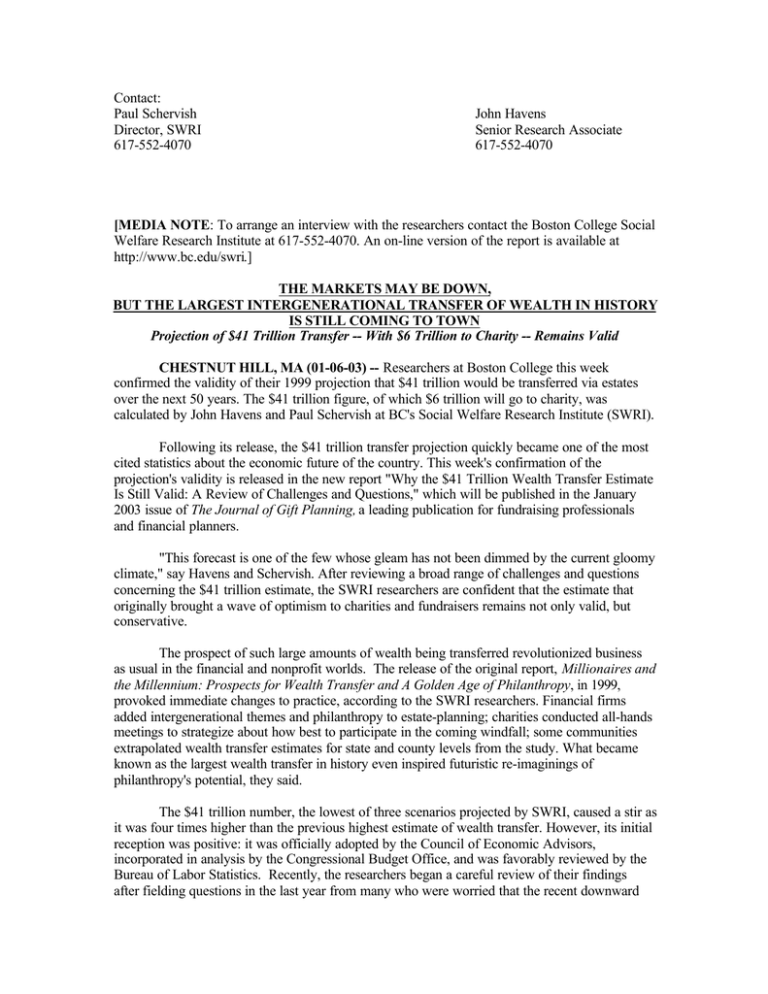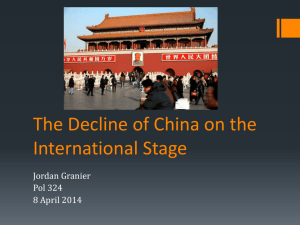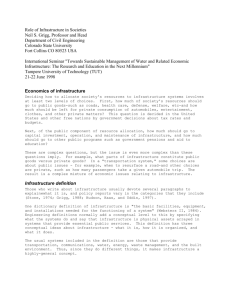Contact: Paul Schervish John Havens Director, SWRI
advertisement

Contact: Paul Schervish Director, SWRI 617-552-4070 John Havens Senior Research Associate 617-552-4070 [MEDIA NOTE: To arrange an interview with the researchers contact the Boston College Social Welfare Research Institute at 617-552-4070. An on-line version of the report is available at http://www.bc.edu/swri.] THE MARKETS MAY BE DOWN, BUT THE LARGEST INTERGENERATIONAL TRANSFER OF WEALTH IN HISTORY IS STILL COMING TO TOWN Projection of $41 Trillion Transfer -- With $6 Trillion to Charity -- Remains Valid CHESTNUT HILL, MA (01-06-03) -- Researchers at Boston College this week confirmed the validity of their 1999 projection that $41 trillion would be transferred via estates over the next 50 years. The $41 trillion figure, of which $6 trillion will go to charity, was calculated by John Havens and Paul Schervish at BC's Social Welfare Research Institute (SWRI). Following its release, the $41 trillion transfer projection quickly became one of the most cited statistics about the economic future of the country. This week's confirmation of the projection's validity is released in the new report "Why the $41 Trillion Wealth Transfer Estimate Is Still Valid: A Review of Challenges and Questions," which will be published in the January 2003 issue of The Journal of Gift Planning, a leading publication for fundraising professionals and financial planners. "This forecast is one of the few whose gleam has not been dimmed by the current gloomy climate," say Havens and Schervish. After reviewing a broad range of challenges and questions concerning the $41 trillion estimate, the SWRI researchers are confident that the estimate that originally brought a wave of optimism to charities and fundraisers remains not only valid, but conservative. The prospect of such large amounts of wealth being transferred revolutionized business as usual in the financial and nonprofit worlds. The release of the original report, Millionaires and the Millennium: Prospects for Wealth Transfer and A Golden Age of Philanthropy, in 1999, provoked immediate changes to practice, according to the SWRI researchers. Financial firms added intergenerational themes and philanthropy to estate-planning; charities conducted all-hands meetings to strategize about how best to participate in the coming windfall; some communities extrapolated wealth transfer estimates for state and county levels from the study. What became known as the largest wealth transfer in history even inspired futuristic re-imaginings of philanthropy's potential, they said. The $41 trillion number, the lowest of three scenarios projected by SWRI, caused a stir as it was four times higher than the previous highest estimate of wealth transfer. However, its initial reception was positive: it was officially adopted by the Council of Economic Advisors, incorporated in analysis by the Congressional Budget Office, and was favorably reviewed by the Bureau of Labor Statistics. Recently, the researchers began a careful review of their findings after fielding questions in the last year from many who were worried that the recent downward trend in equity markets might mean that the ultimate transfer would fall short of $41 trillion. In the new report, however, the researchers conclude that "the relevant question is not whether $41 trillion will be transferred, but how much more than $41 trillion will be transferred." Given current economic conditions, one of the more surprising findings the researchers reveal is that, contrary to expectation, personal wealth has not dropped significantly below the 1998 estimate of wealth, on which the original report was based. Although the dramatic shrinkage in foundation endowments and the evaporation of the wealth of a few high-tech leaders have recently received a great deal of attention, Havens emphasizes that a close look at the numbers on individual wealth tells a different story—one with a happier ending. "Personally held wealth stands at about $32 trillion in the second quarter of 2002, almost exactly where it was in 1998 when we developed the projection. Individuals rebalanced their portfolios so that the drop in stocks was offset in part, for example, by growth in real estate." "The news should come as a great relief to universities and charities across the country who expanded their development offices and overhauled their staff in response to our prediction that $6 trillion would be bequeathed to charity over the next 50 years," said Schervish. "And because individual wealth has not fallen below the 1998 level used in the first report, the World War II and baby boom generations in particular will be giving away just as much wealth as when we first prophesied a 'Golden Age of Philanthropy,'" added Havens. Among other issues, the researchers looked carefully at how the spending down of savings occasioned by increased lifespan would potentially affect their wealth transfer simulation. Havens points out that, "While people are living longer, their increased consumption at the end of life is being balanced by a number of trends—two of the most important are later retirement age and the increased tendency for the elderly to work at least part-time during retirement. Furthermore our estimates were sufficiently conservative that retirees can easily spend down a larger chunk of their wealth without affecting the $41 trillion total, which we based on long-term trends in economic growth and life-cycle savings rates." Who will benefit from the wealth transfer? "It is important to note that the wealth transfer is going to be split unevenly between the wealthy and the non-wealthy," Havens cautions. "In 2052 we will be able to look back and say that two thirds of the transfer came from only 7% of estates—the very wealthiest." The researchers also advise baby boomers against counting their chickens: "Wealth transfer is not the same as inheritance," says Schervish, "in fact, only $25 trillion of the $41 trillion total is going to go to heirs. The baby boomers' share will be considerably less than that, about $7.2 trillion; so over the five decades of the transfer the boomers will play a more important role as benefactors than as beneficiaries." For fundraisers and nonprofits, their share of the whopping $6 trillion that will be transferred over the next five decades will depend in large part on their ability to deal with another legacy—that of the 1990s boom, which Mary O'Herlihy of BC's Social Welfare Research Institute, says, "created a generation of younger and more engaged givers, whose contributions to charitable causes are in response to both societal needs and their own need for effectiveness and significance." The complete report "A Review of the $41 Trillion Wealth Transfer Estimate" can be downloaded free at http://www.bc.edu/swri and will be published in January 2003 by the Journal of Gift Planning. The report deals with the following themes: implications of recent economic trends for wealth transfer; whether the value of personally held wealth has significantly changed since 1999; what increased longevity, annuitization of assets, and increased consumption among the elderly mean for wealth transfer; what role the baby boomers play in wealth transfer; how the wealth transfer will be divided; and how trends toward lifetime giving may interact with bequests to charity. A detailed summary of the report follows. "Why the $41 Trillion Wealth Transfer Estimate Is Still Valid: A Review of Challenges and Questions" EXECUTIVE SUMMARY Despite the economic downturn and the fall of the equity markets, the nationally noted projection that a wealth transfer of at least $41-trillion will take place in the United States by the year 2052 remains valid, according to researchers at the Boston College Social Welfare Research Institute (SWRI), which issued the original projection in 1999. Following a thorough review of their 1999 report Millionaires and the Millennium: New Estimates of the Forthcoming Wealth Transfer and the Prospects for a Golden Age of Philanthropy, the Boston College researchers conclude in "A Review of the $41 Trillion Wealth Transfer Estimate," that its projections have not been significantly affected by recent and prevailing economic conditions. According to co-author Paul Schervish, the "current report reviews the validity of the $41 trillion estimate in light of recent economic conditions, as well as several other critical challenges. While the new commentary does not explicitly deal with the middle- and upper-growth scenarios, the arguments made in support of the $41 trillion estimate often apply to the higher estimates. The principal conclusion," he said, "is that the $41 trillion estimate remains valid as a 2% growth estimate, even in light of recessionary growth, depressed stock market, and several other criticisms discussed in the new report." The following are some of the major challenges the authors have received and to which they respond in the new report: Challenge 1 The wealth transfer estimate is based on the robust growing economy during the latter half of the 1990s and fails to account for current and/or future recessions and downturns in equity, real estate, or other markets. The SWRI researchers respond that the $41 trillion wealth transfer estimate assumes only a 2% secular real rate of growth in the $32 trillion of personally held wealth in 1998 rather than the high rates of growth in personally held wealth attained in the late 1990s. Even if recessions are more common than expansions during the 55 years spanned by the simulation, the $41 trillion estimate, which assumes only a 2% secular trend in the growth of personally held wealth, is based on growth rates below historic secular trends. Challenge 2 The wealth transfer estimate is based on an unusually high level of personally owned wealth when stocks and bonds were near historic peaks; the estimate would be significantly lower were it based on the current level of personally owned wealth. Like the secular growth rates, the $32 trillion baseline estimate of personally owned wealth used in the original report is a conservative, low estimate and compares with the estimates released for 2001 by Federal Reserve Flow of Funds Accounts implying that total household wealth amounted to at least $32 trillion in 1998. Although household wealth surpassed $32 trillion after 1998, reaching a peak of about $36 trillion in 1999, in the second quarter of 2002 it returned to its 1998 level of $32 trillion (1998 dollars). Therefore, were the wealth transfer estimates based on the current level of household wealth instead of the 1998 value, they would remain unchanged. Specifically, the low-growth scenario would still produce an estimate of $41 trillion. Challenge 3 The majority of Americans start to spend down their assets when they reach retirement and the wealth transfer estimates do not take into account this expenditure pattern. Most American families do begin to spend down their assets when they reach retirement and most non-wealthy families continue to spend down their assets thereafter. However, for most wealthy families, a brief period of spending down their assets at retirement age is followed by a growth of assets in their later years that exceeds their dissaving (drawing down of assets). The low-growth scenario assumes that both wealthy and non-wealthy Americans consume their assets during retirement faster than in reality, thus allowing for retired American parents to spend an even larger amount of "their children's inheritance" without reducing the $41 trillion estimate. Challenge 4 Americans have been living longer and are projected to live even longer in the future. The average American family will be spending their assets for a longer period of time, leaving smaller amounts of wealth to be transferred than is estimated by the simulation. Not counting the effect of greater labor force participation among older workers, the net effect of an additional year of life for all Americans would be to decrease the $41 trillion estimate, but to decrease it by less than $0.3 trillion. For all retirees regardless of wealth, the final estates of those that remain in the labor force will have a larger value than the estates of those who do not work during retirement years. Thus, when coupled with increased labor force participation among older workers, an additional year of life for all Americans could actually increase the $41 trillion estimate by a small amount. Challenge 5 If the trend toward increased annuitization continues, the amount of wealth to be transferred will decline because in order to purchase an annuity, individuals need to draw down their assets and because an annuity ceases to exist when the recipient dies, and so contributes no value to the estate of the recipient/decedent. If the $41 trillion estimate does not take into account the reduction in wealth due to increased amounts of annuities, it will over-estimate the coming wealth transfer. We conclude that on balance the $41 trillion estimate is not compromised by the current level and trends in annuitization, or by the way the current simulation model takes them into account. If anything, the growth in defined-contribution pensions, the tendency to receive distributions from definedcontribution plans as assets, and the tendency to spend from such assets at a lower rate than had the pension been received as annuity income, combine to make it likely that more than $41 trillion will be transferred. Challenge 6 The projected estimate is unrealistic since the baby-boom generation, the largest generation ever, will not inherit anything close to $41 trillion. Many queries about the $41 trillion wealth transfer estimate—often from boomers themselveswrongly assume two things about our report: first, that the entire transfer of wealth is going to heirs; and second, that it is going only to boomers. First, "wealth transfer" is not synonymous with "inheritance." Our original report carefully points out that only $25 trillion of the $41 trillion transfer will pass from decedents' estates to their heirs. The remaining $17 trillion will go to estate taxes, charitable bequests, and estate settlement expenses. Second, it is equally important to understand that while $25 trillion is going to heirs, that figure is the amount of wealth that will be inherited from 1998 through 2052 by all generations—and not just the boomers. Boomers may well inherit $7.2 trillion, but the majority of the inheritances will be transferred to subsequent generations, including the children and grandchildren of the boomers. As the boomer generation ages and dies during the 55-year period, their role in the wealth transfer process will be far greater as benefactors than as beneficiaries. Challenge 7 Only approximately 2% of estates, those of the wealthiest citizens who die each year, are required to file federal estate tax forms. Since wealth transfer is concentrated among this very small fraction of estates, the vast majority of estates will not participate significantly in the $41 trillion wealth transfer. The $41 trillion is an estimate of total wealth transfer via final estates of the entire 1998 adult population, regardless of the size of the estate. The inequality of the size of estates does not affect the $41 trillion estimate and how it is divided: $6.0 trillion in total charitable bequests, $24.6 trillion in total bequests to heirs, $8.5 trillion in total estate taxes, and $1.6 trillion in total estate fees. Challenge 8 The $41 trillion transfer is not a realistic estimate of wealth transfer since the vast majority of heirs will receive small inheritances, if any. From the outset, it must be noted that not all of the $41 trillion transfer is going to heirs, and that substantial amounts are going to charity, taxes, and fees. The share of the low-growth estimate of wealth transfer going to heirs is $25 trillion. Because most estates have more than one heir, the size of inheritance will be relatively small per heir, and the effect will be diffused throughout the population. The fundamental point in regard to the relative shares of the estate going to heirs, to taxes, to charity, or to estate fees—all of which are documented in the original report—is that they do not affect the validity of the $41 trillion wealth transfer estimate. Challenge 9 Robert B. Avery and Michael S. Rendall estimated an intergenerational wealth transfer of $10.4 trillion for the 55-year period from 1990 through 2044. Why is this simulation figure four times higher? Avery and Rendall's $10.4 trillion estimate is not an estimate of the transfer of wealth from the entire 1989 adult population over the subsequent 55 years, but an estimate only of wealth to be transferred from the World War II generation to their baby boom children, estate taxes, charitable bequests, and estate fees. In contrast, SWRI's $41 trillion estimate is a low estimate of wealth to be transferred over the 55-year period from 1998-2052 from the estates of the entire 1998 adult population (age 18 and over) to heirs, taxes, charity, and fees. SWRI's goal was to estimate the total wealth transfer from the entire 1998 adult population during the 55 years from 1998 through 2052, rather than from the segment aged 50 and older with children. SWRI's simulation also starts with a larger pool of wealth. The wealth of the 1998 population was 5.27% larger in real terms compared to the wealth of the 1989 population. Finally, SWRI's simulation includes wealth transferred from aging baby boomers as well as wealth transferred to them. The bulge in the size of the boomer generation produces a similar bulge in the number of estates and the aggregate amount to be transferred when the boomers die. About the researchers John J. Havens is a senior research associate and associate director of the Social Welfare Research Institute at Boston College. He received his training in mathematics, economics and physics at Yale University and his graduate training in economics at the Massachusetts Institute of Technology. Havens' work at SWRI began when he directed the construction and application of the Multi-Regional Policy Impact Simulation (MRPIS) model, a detailed computer model of the national economy, which was used to estimate the economic impacts in a wide range of public policies. From 1992 to the present, Havens has participated in a study of philanthropy at SWRI, conducting advanced statistical analysis of national datasets, as well as surveys and in-depth interviews with the wealthy. Havens was recognized in 2002 for the second time as a member of the Nonprofit Times, "Power and Influence Top 50," a list that acknowledges the most effective leaders in the nonprofit world. Paul G. Schervish is a professor of sociology and director of the Social Welfare Research Institute at Boston College, and a national research fellow at the Indiana University Center on Philanthropy. He received a bachelor's degree in literature from the University of Detroit, a masters in sociology from Northwestern University, a masters of divinity degree from the Jesuit School of Theology at Berkeley, and a Ph.D. in sociology from the University of Wisconsin. Schervish was a Fulbright professor of philanthropy for the 2000-2001 academic year at University College, Cork, Ireland. He has been selected in 2000, 2001 and 2002 to the NonProfit Times, "Power and Influence Top 50." In 2001, Schervish, with colleagues John Havens and Mary O'Herlihy, completed the 2001-High Tech Donors Study based on interviews with high-tech donors and informants about the strategies of wealth accumulation and allocation which are described as agent-directed wealth and philanthropy. Schervish serves regularly as a speaker and consultant on how to surface and analyze the moral biographies of wealth holders, on the motivations for charitable giving, and on the spirituality of financial life. The Social Welfare Research Institute (SWRI) at Boston College is a multidisciplinary research center specializing in the study of spirituality, wealth, philanthropy and other aspects of cultural life in an age of affluence. Founded in 1970, SWRI is a recognized authority on the relation between economic wherewithal and philanthropy, the motivations for charitable involvement, and the underlying meaning and practice of care. ###









